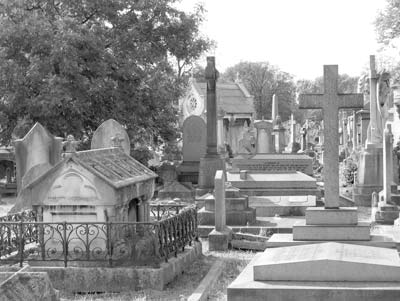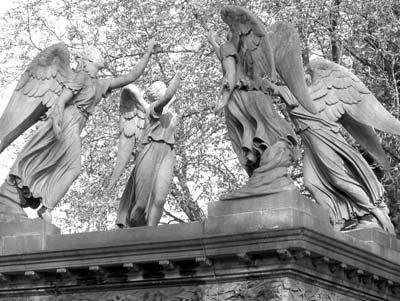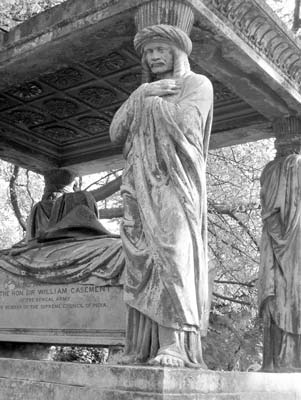Day (tour) of the Dead, London
Kensal Green is indeed aptly called “London’s foremost necropolis.” I took a tour of the cemetery on Sept. 17, 2006, and the 90-minute tour (which cost £5 [near $10], including tea and biscuits) revealed many facts of interest about the historical cemetery’s inhabitants.
Established in 1832 by private ownership, these 76 acres provided an ideal alternative to overcrowded medieval churchyards. A clientele developed, slowly, as this area was then so remote from London proper. Success was assured when the sixth son of George III, HRH, the Duke of Sussex chose Kensal in 1843 for his future resting place, and it was endorsed again in 1848 when his sister, Princess Sophia, selected the same site for her remains.
Originally conceived as a large gentlemen’s park, a competition was held for the building architecture; Gothic won the prize, but neoclassical was finally chosen. You would have no disagreement with this choice as you pass through the main entrance, turn right and stroll toward the Anglican Chapel. The mind’s eye sees, at the end of the wide path, a grand southern Georgia plantation straight out of “Gone With the Wind.” Splendid, mature trees and majestically unique statuary complement the grandeur of an especially pleasurable walk.
The chapel is where our tour started, with a foreword by our very glib guide, Joe. He explained the operation of the catafalque’s hydraulic setting for caskets to be lowered into the catacombs. As for coffins on their way to or from the outside, the traditional “feet first” preference is maintained by the catafalque’s ability to also be a turntable.
A cobwebbed, circular stairway with triangular steps led to the catacombs. It was dank and dark, and stalactites hither and yon gave a sinister milieu to the setting. We got a good look at the underside of the catafalque mechanism, which is made of wood and metal and was restored at a cost of £50,000.
In these vaults, 4,000 spaces are available and three-quarters are occupied. Catacombs are no longer a part of British culture, as 72% of the population today is cremated. However, moneyed people can buy into large vaults that hold a triple coffin.
The aboveground tour is a fascinating pleasure for anyone interested in sculpture, art, romance, poetry and famous personages. Joe, who had a superb gift of humorous loquacity, shared information about the famous people interred there, including Sir Winston Churchill’s darling daughter, Marigold, who died at age three from septicemia, and Sir John Ross, Arctic explorer, for whom the Ross Sea and the Ross Ice Shelf are named.
The final part of our tour was the area to the left of the main entrance where, Joe told us, dissenters from the Anglican faith were buried in the 19th century. Our group then convened at The Dissenters’ Hall for tea and biscuits.
No appointment is needed to take the tour, which is given at 2 p.m. every Sunday regardless of weather (although tours of the catacombs are given only on the first and third Sunday of the month). There is much walking involved, and the catacombs are not suitable for children under the age of 12.
For information about the tour, contact The Friends of Kensal Green Cemetery (phone +44 [0] 20 8969 0152 or visit www.kensalgreen.co.uk). The cemetery’s address is Harrow Road, London W10 4RA, U.K. Take tube stop Kensal Green (Bakerloo Line); it’s nine minutes’ walk from the stop. The number 18 bus passes both cemetery gates, and numbers 52, 70 and 316 are within five minutes’ walk of the main entrance. There is also parking within the cemetery.
The general tour can also be tailored to your request or for special-interest groups (for example, “Ne’er-do-wells,” “Great and Notorious Women,” “Science, Medicine and the Law” and “19th Century Writers,” to name a few).
A.J. GOODHEAD
La Jolla, CA



